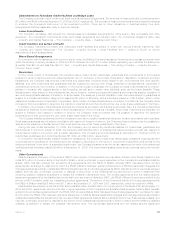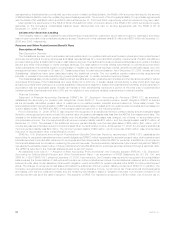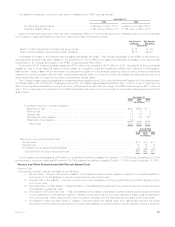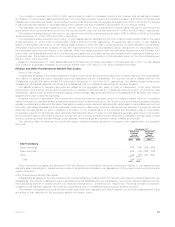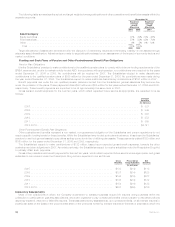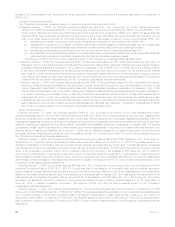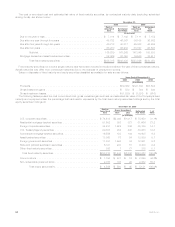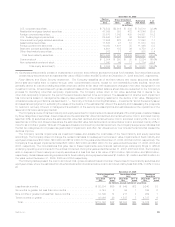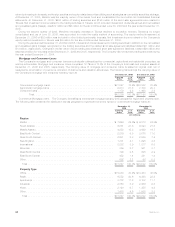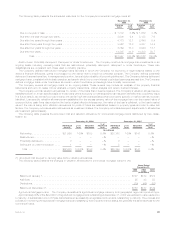MetLife 2006 Annual Report Download - page 62
Download and view the complete annual report
Please find page 62 of the 2006 MetLife annual report below. You can navigate through the pages in the report by either clicking on the pages listed below, or by using the keyword search tool below to find specific information within the annual report.In June 2005, the EITF reached consensus on Issue No. 04-5, Determining Whether a General Partner, or the General Partners as a
Group, Controls a Limited Partnership or Similar Entity When the Limited Partners Have Certain Rights (“EITF 04-5”). EITF 04-5 provides a
framework for determining whether a general partner controls and should consolidate a limited partnership or a similar entity in light of
certain rights held by the limited partners. The consensus also provides additional guidance on substantive rights. EITF 04-5 was effective
after June 29, 2005 for all newly formed partnerships and for any pre-existing limited partnerships that modified their partnership
agreements after that date. For all other limited partnerships, EITF 04-5 required adoption by January 1, 2006 through a cumulative effect
of a change in accounting principle recorded in opening equity or applied retrospectively by adjusting prior period financial statements. The
adoption of the provisions of EITF 04-5 did not have a material impact on the Company’s consolidated financial statements.
Effective November 9, 2005, the Company prospectively adopted the guidance in FASB Staff Position (“FSP”) No. FAS 140-2,
Clarification of the Application of Paragraphs 40(b) and 40(c) of FAS 140 (“FSP 140-2”). FSP 140-2 clarified certain criteria relating to
derivatives and beneficial interests when considering whether an entity qualifies as a QSPE. Under FSP 140-2, the criteria must only be met
at the date the QSPE issues beneficial interests or when a derivative financial instrument needs to be replaced upon the occurrence of a
specified event outside the control of the transferor. The adoption of FSP 140-2 did not have a material impact on the Company’s
consolidated financial statements.
Effective July 1, 2005, the Company adopted SFAS No. 153, Exchanges of Nonmonetary Assets, an amendment of APB Opinion No. 29
(“SFAS 153”). SFAS 153 amended prior guidance to eliminate the exception for nonmonetary exchanges of similar productive assets and
replaced it with a general exception for exchanges of nonmonetary assets that do not have commercial substance. A nonmonetary
exchange has commercial substance if the future cash flows of the entity are expected to change significantly as a result of the exchange.
The provisions of SFAS 153 were required to be applied prospectively for fiscal periods beginning after June 15, 2005. The adoption of
SFAS 153 did not have a material impact on the Company’s consolidated financial statements.
Effective July 1, 2005, the Company adopted EITF Issue No. 05-6, Determining the Amortization Period for Leasehold Improvements
(“EITF 05-6”). EITF 05-6 provides guidance on determining the amortization period for leasehold improvements acquired in a business
combination or acquired subsequent to lease inception. As required by EITF 05-6, the Company adopted this guidance on a prospective
basis which had no material impact on the Company’s consolidated financial statements.
In June 2005, the FASB completed its review of EITF Issue No. 03-1, The Meaning of Other-Than-Temporary Impairment and Its
Application to Certain Investments (“EITF 03-1”). EITF 03-1 provides accounting guidance regarding the determination of when an
impairment of debt and marketable equity securities and investments accounted for under the cost method should be considered
other-than-temporary and recognized in income. EITF 03-1 also requires certain quantitative and qualitative disclosures for debt and
marketable equity securities classified as available-for-sale or held-to-maturity under SFAS No. 115, Accounting for Certain Investments in
Debt and Equity Securities, that are impaired at the balance sheet date but for which an other-than-temporary impairment has not been
recognized. The FASB decided not to provide additional guidance on the meaning of other-than-temporary impairment but has issued FSP
Nos. FAS 115-1 and FAS 124-1, The Meaning of Other-Than-Temporary Impairment and its Application to Certain Investments (“FSP
115-1”), which nullifies the accounting guidance on the determination of whether an investment is other-than-temporarily impaired as set
forth in EITF 03-1. As required by FSP 115-1, the Company adopted this guidance on a prospective basis, which had no material impact on
the Company’s consolidated financial statements, and has provided the required disclosures.
In December 2004, the FASB issued FSP No. FAS 109-2, Accounting and Disclosure Guidance for the Foreign Earnings Repatriation
Provision within the American Jobs Creation Act of 2004 (“FSP 109-2”). The AJCA introduced a one-time dividend received deduction on
the repatriation of certain earnings to a U.S. taxpayer. FSP 109-2 provides companies additional time beyond the financial reporting period
of enactment to evaluate the effects of the AJCA on their plans to repatriate foreign earnings for purposes of applying SFAS No. 109,
Accounting for Income Taxes. During 2005, the Company recorded a $27 million income tax benefit related to the repatriation of foreign
earnings pursuant to Internal Revenue Code Section 965 for which a U.S. deferred income tax provision had previously been recorded. As
of January 1, 2006, the repatriation provision of the AJCA no longer applies to the Company.
Effective July 1, 2004, the Company prospectively adopted FSP No. FAS 106-2, Accounting and Disclosure Requirements Related to
the Medicare Prescription Drug, Improvement and Modernization Act of 2003 (“FSP 106-2”). FSP 106-2 provides accounting guidance to
employers that sponsor postretirement healthcare plans that provide prescription drug benefits. The Company began receiving subsidies
on prescription drug benefits during 2006 under the Prescription Drug Act based on the Company’s determination that the prescription
drug benefits offered under certain postretirement plans are actuarially equivalent to the benefits offered under Medicare Part D. The
postretirement benefit plan assets and accumulated benefit obligation were remeasured to determine the effect of the expected subsidies
on net periodic postretirement benefit cost. As a result, the accumulated postretirement benefit obligation was reduced by $213 million at
July 1, 2004.
Effective July 1, 2004, the Company adopted EITF Issue No. 03-16, Accounting for Investments in Limited Liability Companies (“EITF
03-16”). EITF 03-16 provides guidance regarding whether a limited liability company should be viewed as similar to a corporation or similar
to a partnership for purposes of determining whether a noncontrolling investment should be accounted for using the cost method or the
equity method of accounting. EITF 03-16 did not have a material impact on the Company’s consolidated financial statements.
Effective April 1, 2004, the Company adopted EITF Issue No. 03-6, Participating Securities and the Two — Class Method under FASB
Statement No. 128 (“EITF 03-6”). EITF 03-6 provides guidance on determining whether a security should be considered a participating
security for purposes of computing earnings per common share and how earnings should be allocated to the participating security. EITF
03-6 did not have an impact on the Company’s earnings per common share calculations or amounts.
Effective January 1, 2004, the Company adopted SOP 03-1 as interpreted by a Technical Practice Aid (“TPA”), issued by the American
Institute of Certified Public Accountants (“AICPA”) and FSP No. FAS 97-1, Situations in Which Paragraphs 17(b) and 20 of FASB Statement
No 97, Accounting and Reporting by Insurance Enterprises for Certain Long-Duration Contracts and for Realized Gains and Losses from
the Sale of Investments, Permit or Require Accrual of an Unearned Revenue Liability. SOP 03-1 provides guidance on: (i) the classification
and valuation of long-duration contract liabilities; (ii) the accounting for sales inducements; and (iii) separate account presentation and
valuation. As a result of the adoption of SOP 03-1, effective January 1, 2004, the Company decreased the liability for future policyholder
benefits for changes in the methodology relating to various guaranteed death and annuitization benefits and for determining liabilities for
certain universal life insurance contracts by $4 million, which was reported as a cumulative effect of a change in accounting. This amount is
net of corresponding changes in DAC, including VOBA and unearned revenue liability, under certain variable annuity and life contracts and
59MetLife, Inc.


